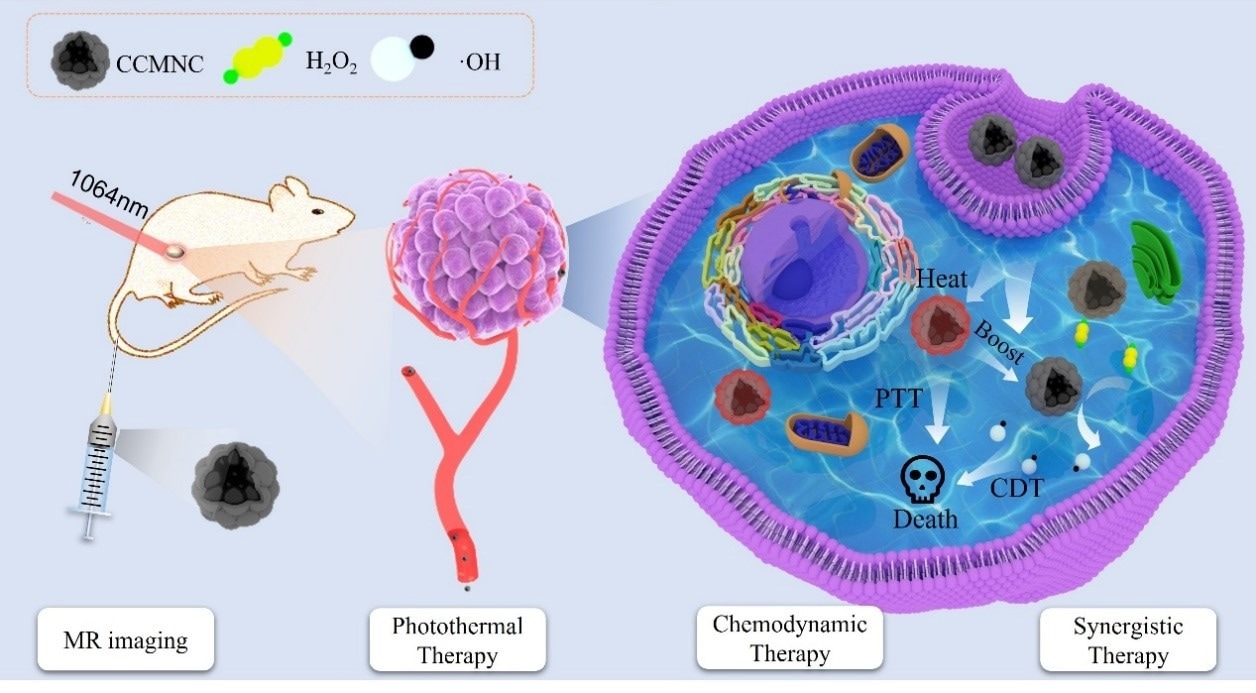A near-infrared (NIR)-II-responsive carbon-coated iron oxide nanocluster has been the focus of new research by Professor Hui Wang, Professor Wenchu Lin and Associate Professor Junchao Qian from the Hefei Institutes of Physical Science (HFIPS) of the Chinese Academy of Sciences, showing promise in enhancing integrated photothermal and chemodynamic therapy (CDT) for synergistic cancer therapy.
 Schematic diagram of the CCMNCs for MR imaging, NIR-II-induced PTT-enhanced CDT. Image Credit: LIN Yefeng.
Schematic diagram of the CCMNCs for MR imaging, NIR-II-induced PTT-enhanced CDT. Image Credit: LIN Yefeng.
Due to reduced adverse effects and easy administration, CDT has become a popular cancer treatment. CDT relies on the following process to work: the intracellular Fention reaction is triggered by nanozymes, resulting in excess production of hydroxyl radicals. These radicals are toxic to cancerous cells, resulting in the death of the cells.
Magnetite nanocrystals have been extensively utilized as Fenton reagents as a result of their biocompatibility and non-invasive imaging ability. However, when magnetite nanocrystals are used as nanozymes, their ferromagnetic behavior and simple oxidization result in colloidal instability and restrict imaging-guided cancer therapy.
In this study, the scientists make use of a one-step solvothermal technique to generate carbon-coated magnetite nanoclusters (CCMNCs) with optical absorption in the NIR-II (1,000-1,100 nm). The team achieved this by tuning the carbon coating of magnetite nanocrystals and cluster structure.
The CCMNCs possess superparamagnetic nature and fast magnetic response for separation, enabling them to be used as a contrast agent for T2-weighted MRI.
Hui Wang, Study Lead and Professor, Hefei Institutes of Physical Science, Chinese Academy of Sciences
Furthermore, Wang described how the CCMNCs worked. Fe2+ and Fe3+ were discovered in the dissolution of CCMNCs in the tumor microenvironment. Fe2+ produced OH in situ in cells and mice, which in turn helped kill cancer cells and curbed tumor growth via CDT effects. Fe3+ could help decrease intracellular glutathione levels and improve the deleterious effects caused by OH, thus enhancing CDT efficiency.
The researchers came to the conclusion that the CCMNCs could efficiently absorb and convert NIR-II irradiation into cytotoxic heat, thereby improving tumor CDT efficiency and further generating synergistic therapeutic effects.
This study was financially supported by the National Key R&D Program of China, the National Natural Science Foundation of China, and the Hefei Institutes of Physical Science Director's Fund.
Journal Reference:
Lin, Y., et al. (2023) NIR-II Responsive Carbon Coated Magnetite Nanoclusters for Magnetic Resonance Imaging-Guided Photothermal-enhanced Chemodynamic Therapy. Science China Materials. doi.org/10.1007/s40843-022-2389-5.